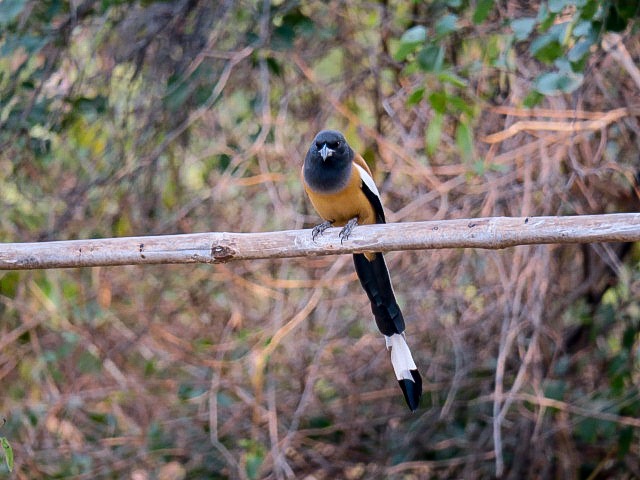While I prepare my posts on my just completed, glorious journey through the Canadian Rockies, let me provide some photos of the many birds I “met” in India –
Friends and family will not be surprised that I was given the title of “Bird Girl” by a fellow traveler in India – since my journey to Peru I have been somewhat (!) obsessed with capturing photos of birds, both locally and during my travels. This of course dovetails (pun intended) with my overall passion for nature photography. India provided ample opportunities. I have previously shared my photos of birds discovered in South India, but for people who haven’t seen my previous India birds posts, let me give you this sampling.
Let’s start with the most iconic Indian bird, the peafowl. The male peacock is most familiar with its dazzling array of iridescent back feathers that shimmer in the sun during mating season to attract a female peahen. The peacocks I saw did not have the full brilliant fan of feathers that the breed is so well-known for. Nature has its own rhythms, and every year, at end of summer, peacocks’ long plumage molts. Hormones trigger the beginning of the molting process, which is timed to occur after the mating season to allow for the energy required to grow the new feathers in time for mating season in the spring. Timing is everything (my first trip to India was in December). They are still fascinating birds:
A fellow India traveler sent this picture from an extended journey in India after ours ended and graciously allowed me to share – I guess his peacock was practicing for the spring season opener:
The bird powers that be were shining on me even on my first day in Mumbai – although it took a bit of camera trickery to catch these kites – medium size raptors – that were located behind netting constructed to keep them away from the hotel guests:
And someone up there has a keen sense of humor positioning all those “kites” stuck on an antenna:
The big kahunas were also abundant – take a look at these eagles:
Some birds were ubiquitous – similar to where I live near the Long Island Sound in NYC – seagulls, crows, ducks (common coots) and pigeons:
Once in a while a solitary figure would appear to delight, if you are quick enough to spot it:
One of the reasons that I love to take animal portraits is the ability to hone in on their individual personalities – yes animals do express emotion. For example – it is clear that the bulbul below is as curious as to what the heck this human was doing as I was with getting this pose. So let’s get right down to it and see if you can discern what these birds are thinking.
Found plentifully in India, the bulbul, despite how some of my fellow travelers felt is a beautiful songbird, making sunrises particularly beautiful.
Mynah – another of the Indian songbirds (and powerful mimic) who is related to our American starlings. The word ‘mynah’ or ‘myna’ derives from the Hindi word mainā, a term of endearment used for pets, children and favoured females. Mainā itself derives from the Sanskrit madana, meaning joyful or delightful. It is also said to mean ‘messenger of God’ in Sanskriti. It is fortuitous to see two mynahs together
Jungle Babblers – How can you resist birds with a name like this – they congregate in groups, are very gregarious and appear to be particularly Badass:
Rufous Treepie – This bird needs a different name – like Tiger bird, as it has the same coloring as that magnificent feline. Surprisingly to me, it is a member of the crow family – its more flamboyant cousin, I suppose.
Indian White Eye – these birds may be diminutive but I think also quite shrewd – they seem to congregate around other larger birds – perhaps to use them as bodyguards?
There are many birds who speak volumes with their brilliant displays, especially blue, my favorite color:
Tickel’s Blue Flycatcher:
India Blue Tit
Shrike
I did play with a little photoshop coloring on this – for the record:
Blue bird du resistance – it is so rare that even the Panna National Park rangers had never seen one before – and it is hard to miss, being brilliantly colored. However they are extremely skittish so I was happy to catch at least a few decent photos.
Verditer Flycatcher
This common bird deserves the closing of this post as the sparrow was so completely into his bath that I was able to get up close:
#




















































